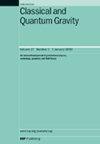Gravitationally induced decoherence of a scalar field: investigating the one-particle sector and its interplay with renormalisation
IF 3.7
3区 物理与天体物理
Q2 ASTRONOMY & ASTROPHYSICS
引用次数: 0
Abstract
We investigate the one-particle sector for the field-theoretical model of gravitationally induced decoherence for a scalar field in Fahn et al (2023 Class. Quantum Grav.40 094002) with a special focus on the renormalisation of the one-particle master equation. In contrast to existing models in the literature, where the renormalisation is usually performed after the Markov and rotating wave approximation (RWA) and often only for certain limits such as the non- or ultra-relativistic limit, here we apply the renormalisation directly after the one-particle projection. With this strategy, we show that UV-divergent contributions in the one-particle master equation can be identified with the vacuum contributions in the self-energy of the scalar field in the effective quantum field theory and depending on the chosen one-particle projection method, its vacuum bubbles, while the additional thermal contributions in the self-energy are all UV-finite. To obtain the renormalised one-particle master equation, we use an on-shell renormalisation procedure of the underlying effective QFT. We then apply the Markov and RWA, specifying a condition under which the Markov approximation can be applied in the case of the ultra-relativistic limit. We compare our results with those available in the literature. This includes an analysis of two different kinds of one-particle projections, a comparison of the application and effects of renormalisation of quantum mechanical and field theoretical models, the non-relativistic and ultra-relativistic limits of the renormalised one-particle master equations, and a comparison with a quantum mechanical toy model for gravitationally induced decoherence in the context of neutrino oscillations.标量场的引力诱导退相干:研究单粒子扇区及其与重整化的相互作用
我们在Fahn et al (2023 Class)中研究了标量场引力诱导退相干场理论模型的单粒子扇区。量子重力。40 094002),特别关注单粒子主方程的重整化。与文献中的现有模型相反,在现有模型中,重整化通常在马尔可夫和旋转波近似(RWA)之后进行,并且通常仅适用于某些极限,如非相对论性或超相对论性极限,这里我们直接在单粒子投影之后应用重整化。利用这一策略,我们证明单粒子主方程中的uv发散贡献可以与有效量子场论中标量场自能中的真空贡献相识别,并且根据所选择的单粒子投影方法,其真空气泡,而自能中的附加热贡献都是uv有限的。为了得到重整化的单粒子主方程,我们使用了底层有效QFT的壳上重整化过程。然后我们应用了马尔可夫近似和RWA,指定了在超相对论极限的情况下马尔可夫近似可以应用的条件。我们将我们的结果与文献中可用的结果进行比较。这包括对两种不同类型的单粒子投影的分析,量子力学和场论模型的重整化的应用和效果的比较,重整化的单粒子主方程的非相对论性和超相对论性极限,以及与中微子振荡背景下引力诱导退相干的量子力学玩具模型的比较。
本文章由计算机程序翻译,如有差异,请以英文原文为准。
求助全文
约1分钟内获得全文
求助全文
来源期刊

Classical and Quantum Gravity
物理-天文与天体物理
CiteScore
7.00
自引率
8.60%
发文量
301
审稿时长
2-4 weeks
期刊介绍:
Classical and Quantum Gravity is an established journal for physicists, mathematicians and cosmologists in the fields of gravitation and the theory of spacetime. The journal is now the acknowledged world leader in classical relativity and all areas of quantum gravity.
 求助内容:
求助内容: 应助结果提醒方式:
应助结果提醒方式:


